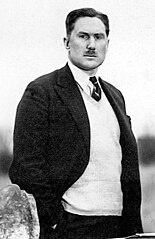| Captain George E.T. Eyston | |
|---|---|
 George Eyston in 1931 | |
| Born |
June 28, 1897 Bampton, Oxfordshire, England[1] |
| Died |
June 11, 1979 (aged 81) Lambeth, London, England |
| Nationality | British |
| Occupation | Land Speed Record holder |

Eyston (left) with fire-damaged MG Midget, 1931[2]
Captain George Edward Thomas Eyston MC OBE (28 June 1897 – 11 June 1979[3]) was a British racing and land speed record car driver in the 1920s and 1930s.[1] He was also an engineer and inventor.
Early life[]
George Eyston was educated at Stonyhurst College and Trinity College, Cambridge. His study of engineering at Cambridge was interrupted by World War I when he was commissioned in the Dorset Regiment[4] and later served in the Royal Field Artillery. After the war he returned to Trinity College and was captain of the First Trinity Boat Club.
Career[]
Motor racing[]
Eyston's racing career began with European road races, particularly in Bugattis, with success in races such as the 1921 and 1926 French Grand Prix [5]
Later he became well known for racing supercharged MGs such as the Magic Midget and the K3 Magnette.[6] His entries with the K3 included the 1933 Isle of Man and 1934 Northern Ireland Tourist Trophy events,[7] and the 1934 Mille Miglia[8][9]
Speed records[]
He fitted a diesel engine from an AEC bus into a car built on a Chrysler chassis and used it to set high-speed endurance records at Brooklands, attaining 100.75 mph in 1933 rand 106 mph in 1936.[10][11]
In 1935, he was one of the first British racers to travel to the Bonneville salt flats of Utah, with his 24 & 48 hour record-setting car Speed of the Wind. He is best known today for land speed records set in his car Thunderbolt.[12] Between 1937 and 1939 he set three new land speed records, wresting them from Malcolm Campbell's Blue Bird, but was twice bettered by John Cobb. The rivalry was friendly, and in later years Eyston, as competitions manager for Castrol, assisted with Cobb's ill-fated attempt on the water speed record in Crusader.[13] He was also involved in the design of his Thunderbolt car at the Bean Cars factory in Tipton, Staffordshire (now West Midlands).[14]
Patents and engineering[]
As an engineer and inventor, he held a number of patents related to motor engineering and particularly supercharging.[15] His work on developing high-power gearboxes was important for Thunderbolt, along with his invention of the Powerplus supercharger used on MGs.
World War II[]
During World War II Eyston served on various bodies connected with industry and was a Regional Controller for the Ministry of Production.
Honours and awards[]
- Eyston was awarded the Military Cross on 18 July 1917 - 2nd Lt. (temp Lt.) George Edward Thomas Eyston, RFA., Spec. Res. For conspicuous gallantry and devotion to duty. He rendered most valuable service when carrying out reconnaissance under heavy fire. On several occasions he went forward under heavy shell and machine gun fire. He carried out his duties with great courage and determination, and was able to obtain most valuable information.[16]
- He was awarded the Segrave Trophy in 1935.[17]
- He was made a chevalier of the Légion d'honneur in 1938.[1]
- He was made an OBE in 1948.[18]
Publications[]
- G.E.T. Eyston (1933). Flat Out. John Miles. foreword by Sir Malcolm Campbell
- G.E.T. Eyston; Barré Lyndon (1935). Motor Racing and Record Breaking.
- George Eyston; W.F. Bradley (1936). Speed on Salt. Batsford.
- George Eyston (1939). Fastest on Earth.
References[]
| Wikimedia Commons has media related to George Eyston. |
- Charles Jennings (2005). The Fast Set. Abacus. ISBN 0-349-11596-6.
- EYSTON, Capt. George Edward Thomas, Who Was Who, A & C Black, 1920–2008; online edn, Oxford University Press, Dec 2007, accessed 8 Aug 2012
- Captain George Eyston (obituary), The Times, London, 23 November 1979, page VIII (Obituaries Supplement)
- ↑ 1.0 1.1 1.2 Colin Dryden (Sept 2004). "Eyston, George Edward Thomas (1897–1979)". Oxford Dictionary of National Biography, Oxford University Press. Digital object identifier:10.1093/ref:odnb/31092. http://www.oxforddnb.com/index/101031092/.
- ↑ http://www.mgccwa.com/Marque%20History.htm
- ↑ The Golden Era of GP Racing 1934-40 - Drivers
- ↑ "No. 28918". 29 September 1914. https://www.thegazette.co.uk/London/issue/28918/page/
- ↑ "George Eyston racing at Montlhery". http://www.mediastorehouse.com/pictures_682688/GEORGE-EYSTON-RACING-AT-MONTLHERY.html. (Commercial photo gallery)
- ↑ Malcolm Green (1997). MG Sportscars. CLB International. ISBN 1-85833-606-6.
- ↑ "The Supercharged Magnette". 11 August 1933.
- ↑ Barré Lyndon (2 March 1934). "Number One".
- ↑ compiled by Peter Garnier, from the archives of Autocar magazine (1979). MG Sports Cars. Hamlyn. ISBN 0-600-36343-0.
- ↑ "Diesel record car in 1936". Brooklands photo archive. http://www.brooklandsarchives.com/Gallery_E10/target26.html.
- ↑ "Diesel record car in 1936". Brooklands photo archive. http://www.brooklandsarchives.com/Gallery_E10/target27.html.
- ↑ "Captain George Eyston: The Empire Club of Canada Speeches 1938-1939". http://www.speedace.info/george_eyston.htm. (includes some images of Thunderbolt)
- ↑ "John Cobb and the Crusader". http://www.lesliefield.com/personalities/john_cobb.htm., reprinted from Leo Villa and Kevin Desmond (1976). The World Water Speed Record.
- ↑ [1]
- ↑ GB 260804, GB 375886, GB 348524 et al.
- ↑ "No. 30188". 18 July 1917. https://www.thegazette.co.uk/London/issue/30188/page/
- ↑ Segrave Trophy – Royal Automobile Club
- ↑ "No. 38161". 1 January 1948. https://www.thegazette.co.uk/London/issue/38161/page/
The original article can be found at George Eyston and the edit history here.